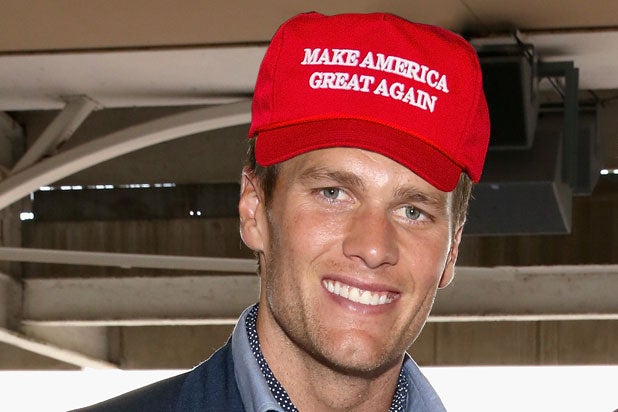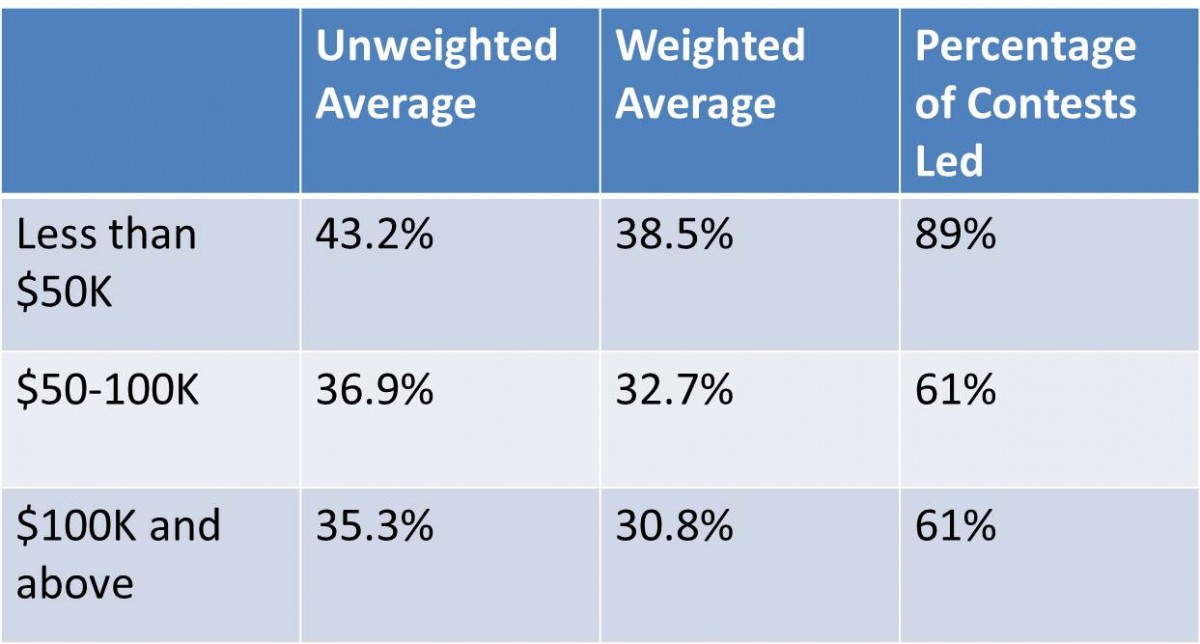Only four days before next Tuesday’s crucial New York primary, the Trump Traveling Circus came to Plattsburgh in upstate New York on Friday, and your intrepid blogger was at the rally. Here’s what I saw.
I had originally intended to attend Trump’s Albany rally last Monday, but begin to hear rumors that Trump was planning an additional rally in upstate New York, closer to where I live, so I postponed the Albany trip. Sure enough, Trump announced that he would be coming to Plattsburgh, a city of about 20,000 located just across Lake Champlain and slightly north from Burlington, Vermont. Trump’s strategy in heading upstate was clear: because New York allocates 81 of its 95 delegates based on the results in its 27 congressional districts (3 delegates per district) and only 14 on a statewide basis, Trump has been crisscrossing the state trying to sew up those congressional delegates. Plattsburgh was the latest stop in the Trump road show. Note that candidates who fail to clear the 20% threshold in a district don’t get any of its delegates so, given current polling, Trump appears to have a good shot at winning almost all the state’s delegates. Based on current delegate projections, doing very well in his home state is crucial to Trump’s effort to lock up the nomination before the convention. Plattsburgh had the additional advantage of having an airport, which allowed Trump to fly out directly after the rally to his next campaign event in Connecticut.
Initially Trump planned to come to on Saturday, but the Crete Civic Center was booked with a home show, so he switched the rally to Friday. That left media organizations scrambling to get credentials, but all the major Vermont and upstate New York outlets were there as far as I could tell, including WCAX’s own Kyle Midura, who has been covering Trump’s candidacy this year. Midura noted that he had been there since 11 a.m., and when we finally left the rally premises at 4:30, the WCAX satellite truck was still there. Although there was some national media there too, there were not nearly the number of national reporters there that I have seen in earlier Trump rallies. But the Trump rally led all the local newscasts in New York and Vermont. (That’s Channel 5’s Stewart Ledbetter on the bottom, Channel 3’s Kyle on top.) The media were located in the center of the arena floor, on a platform. There was a clean camera feed provided by the campaign, so when the talking heads did their stand ups on their own cameras, they could still access events on the main stage using the clean feed.


There were also a healthy number of college students – no surprise here since Plattsburgh is home to SUNY-Plattsburgh, one of the state’s numerous state universities. Since the rally started at 3 p.m., making it hard for working people to attend, the rally was dominated by students, who lent a raucous air to the proceeding, even for a Trump rally. Outside there was the usual row of vendors hawking Trump-related items, including this R-rated t-shirt. (The other side was even more vulgar!)
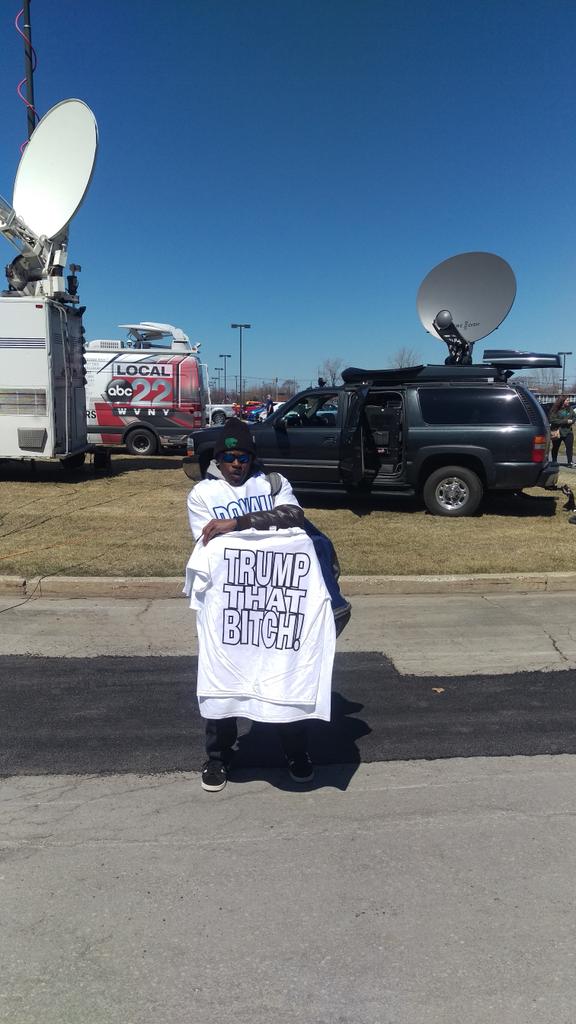
We arrived very early and easily cleared security – in contrast to the Trump rallies I attended in New Hampshire and South Carolina, there were no lines at the security checkpoints here. This gave me ample time to interview people. I talked with a student from SUNY who was covering the event for her communications class. She noted that she recognized many of the students here, and said Trump had strong student support particularly among SUNY’s fraternities. (I saw dozens of students – mostly men – wearing red baseball caps with the slogan “Make America Great Again” along with the occasional “Make Donald Drump Again”.) The women students, she said, seemed more ambivalent about his candidacy. And, in fact, I found almost no women students who would go on record saying they supported The Donald. Several claimed they were only here because their friends were attending.
Interestingly, however, several older women, including a couple of academics working at the university, made it quite clear that they were voting for Trump. They dismissed his incendiary comments, including his disparaging comments about some women, as designed to gain media attention. When asked why they supported him, they said because he is talking about issues that neither party is addressing. Both noted that Trump has increased political discussion and participation among their friends. Again, however, none of the women would allow me to take their picture or identify them. “My colleagues would harass me!” one declares. Clearly, for some, there’s still a stigma attached to being identified openly as a Trump supporter.
Finally, a speaker walked on stage to say Trump’s plane had landed, and to thank us for helping Trump “Make America great again.” The crowd cheered, we recited the Pledge of Allegiance, and the first “USA, USA!” chants broke out. There was a palpable level of anticipation among the crowd, which had now filled slightly more than half the arena floor. (I am later told a head count at the door shows attendance just slightly south of 3,000 people. Reportedly the arena seats 4,000.) And then the Donald walked on stage, to a roar from the crowd. After praising the crowd and this “great part of the world” he immediately launched into this general theme, – “We are going to make America great again” – and proceeded to riff on the issues I’ve heard him address in earlier Trump rallies – the need for smart trade, securing the borders, Lying Ted “he’s so far down in the polls”, John Kasich “he supported NAFTA”, China’s currency manipulation “if growth drops below 7% in China it’s a catastrophe”, repealing Obamacare “it’s been a disaster”, his love of Hispanics, the U.S. debt and how he is not beholden to any special interests “I flew my own plane here”. He recounted how when he began his campaign last June, “no one was talking about immigration.” He reminded the audience that he had outlasted all but two of the 16 Republicans opposing him, and he’s “millions of votes” ahead of the remaining two.
By now, Trump and his followers are so familiar with his material that they both anticipate the punch lines. And so, after describing how he is going to build a “great wall”, one that might have his name on it, and which will have a big door to allow legal immigrants to come back into the country, Trump asks, “And who is going to pay for it?” “Mexico” the crowd roars, delighted with itself. Periodically chants of “Build that wall, build that wall” broke out. (Note the slogan on the back of the young man’s t-shirt.)
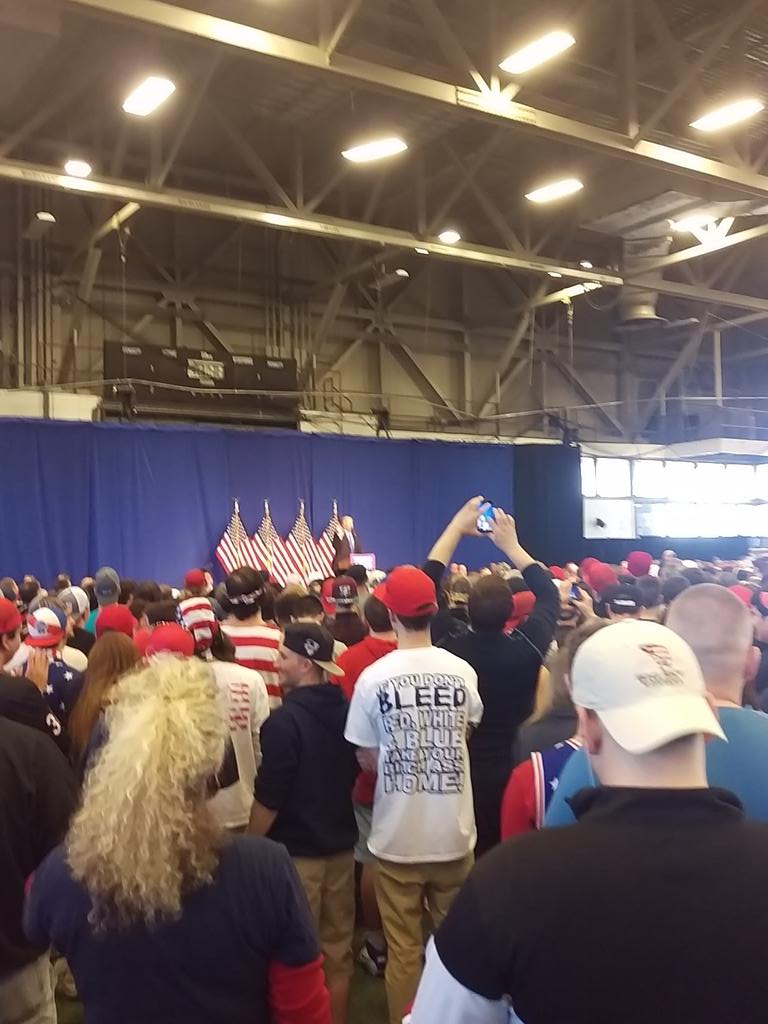
However, some details of the Trump stump speech were clearly tailored for this specific audience. He spent considerable time citing economic statistics documenting an economic slowdown and a loss of jobs in upstate New York, including Plattsburgh. Perhaps most notable, however, was his riff on “New York values” which was a direct attack on Cruz’ effort early in the campaign to use that phrase as a way to portray Trump as a closet liberal who was out of touch with mainstream Republican values. In New York, Trump has taken great delight in throwing that phrase back at Cruz, and at this rally he went into some detail describing just what he means by New York values, referencing a variety of groups that embody those values, including police, and firefighters who went into the World Trade Center on 9-11, and transit workers, and restaurant and factory workers. New York values, Trump declared, refer to “honesty and straight talking even though sometimes that gets me into trouble.” This direct appeal to the “better angels of our nature” was conspicuously absent from Trump’s earlier rallies, and it seemed to play very well with this crowd, which grew noticeably more quiet as he recited the litany of New York values, including love of community and acts of kindness. It also represents an effort, I suspect, to make Trump more palatable to a general election audience.
The other new theme, at least for me, was Trump’s vehement indictment of the “rigged” nominating process. Trump has always sprinkled his stump speech with attacks against the party establishment, but here he went out of his way to critique the process itself, citing in particular the recent Colorado convention that awarded all the state’s Republican delegates to Cruz. Again, as I noted while I was live tweeting the event, this is an effort for Trump to lay the groundwork to rally public opinion to his side in case there’s a contested convention. By suggesting that the Republican Party establishment is gaming the system to prevent him from winning the nomination, Trump bolsters his standing as the outside candidate representing Republican Party voters, if not the elites, and makes it harder for the Party to deny him the nomination even if he falls a bit short in the delegate race.
Throughout the rally I waited for the obligatory protest moment, even as Trump assured us that his rallies are the safest ones, but only one occurred inside the civic center, and it was so small and relatively muted that Trump didn’t even bother to issue his trademark response asking the cameras to focus on his huge crowds. Instead he dismissed the protestors as “weak” and moved on with his speech. (When we left the rally there was about a dozen protestors, with signs, who had been relegated to the street outside the immediate convention premises.) Still while this was clearly a pro-Trump rally, it seemed to me to lack the intensity of passion I’ve seen in earlier Trump rallies, perhaps because this one was dominated by students, many of whom seemed most interested in being part of the circus more than they were in supporting Trump as a candidate. But the rally did not lack for its moments. As he typically does, Trump called out audience members, as when he pointed out this “strong, good looking student” who had been hoisted on to someone’s shoulders and began flexing his biceps. It was that kind of a rally – one as much as a giant frat party as it was political event.

Trump wrapped up his speech with his characteristic recitation of major themes: knocking out ISIS, helping our veterans, winning on the border, winning on trade, winning with health care, getting rid of Common Core (which got one of the biggest cheers of the event), and saving the 2nd amendment (more big cheers.) “We’re going to win so much when I’m president that you are going to come to me and say, ‘we’re sick of winning’ but, no, we are going to keep on winning!” After telling the audience how much he loved them, he waded into the crowd, surrounded by an anxious security detail, and began signing anything that moved.
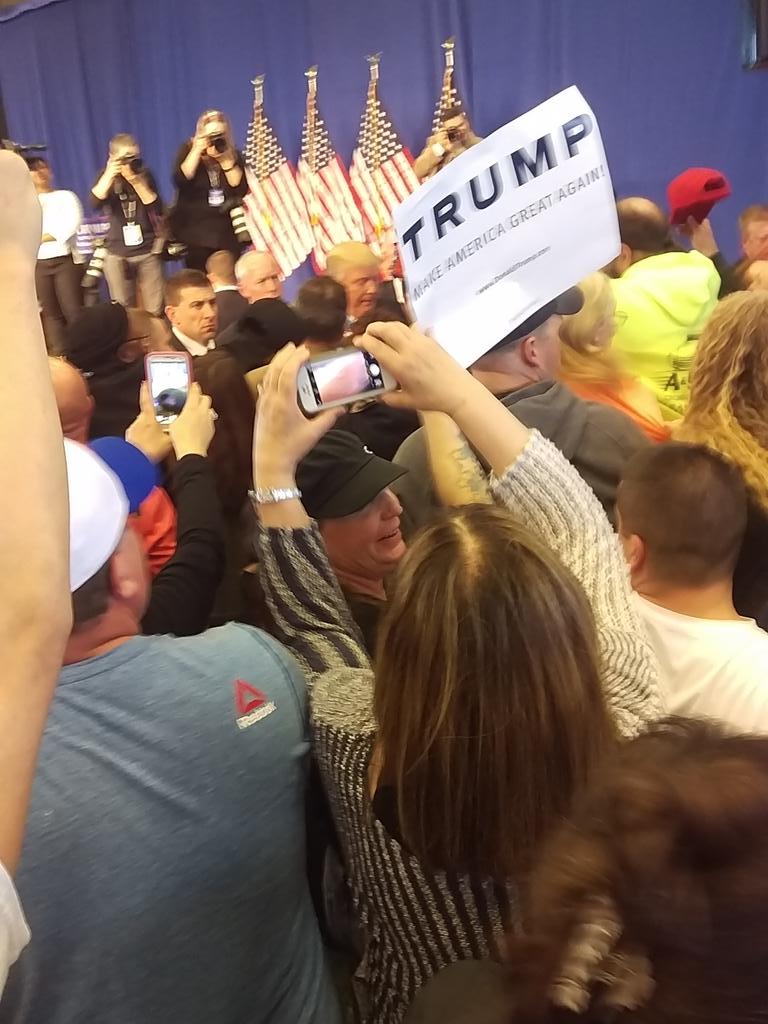
As we watched the crowd swarm in around Trump, my wife struck up a conversation with another woman who said she came with her 16-year old son. “He’s never interested in doing anything,” she told us, but he asked her to bring him to a Trump rally. Like many people we talked to, she acknowledged that Trump is not her ideal candidate, but that he is saying things on issues like immigration and Common Core that need to be said, and she noted – as many in the audience did – that he has boosted interest in politics among her peers. Of course, heightened interest doesn’t necessarily translate into direct support for Trump. But in contrast to some pundits who believe Trump “is not saying anything new or different,” it’s pretty clear from attending these rallies that his supporters think otherwise. Clearly his policy views are resonating with a significant number of potential Republican voters in a way that more mainstream Republicans’ issue stances are not. As I’ve noted elsewhere, he seems to have adopted an effective mix of economic populism on the domestic side and American Security First as his foreign policy that has, so far, proved to be an unorthodox and winning combination among Republicans. It may be that this is because he pushes his views on these topics with a maddening lack of specificity, which allows supporters to infer what they want from Trump’s speeches. Whatever the explanation, it seems to be working.
How well this plays in a general election, of course, remains to be seen. But I know this – I dismissed Trump as cartoon character with no chance of winning once before. I won’t make that mistake again.



